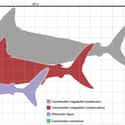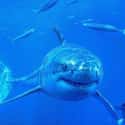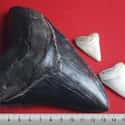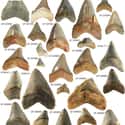-
(#1) It Was Larger Than Any Currently Living Shark
The megalodon reached lengths of 60 feet during its time at the top of the prehistoric food chain. At an average of 23 feet long, the great white shark is roughly the same length as its ancestor's male reproductive organ.
Whale and basking sharks are closer to the megalodon's size, but still fall short at 46 and 33 feet long, respectively.
-
(#2) Its Jaws Could Crush Cars And Whales
Studies conducted by Stephen Wroe of the University of New South Wales in Australia found that the large jaws of the megalodon likely generated a maximum 4,000 pounds of bite force pressure. Its bite force was 10 times that of the great white shark, and even greater than that of the fearsome Tyrannosaurus rex. Theoretically, the prehistoric shark could use its jaws to smash a car like a junkyard crusher - although its approximately 7-inch long teeth would likely not survive.
Fossils of baleen whales living at the same time as the megalodon show bite marks from the fearsome creature - the real reason for the strong jaws.
-

(#3) Its Fossil Record Is Incomplete Due To Its Skeletal Makeup
Shark skeletons contain lots of cartilage, which does not hold up well after death. As a result, the megalodon's fossil record is incomplete. Estimates of the shark's appearance are based on what scientists have available to them: its teeth. The characteristics of megalodon teeth have led scientists to believe they were housed in a broad jaw. Sharks with broad jaws generally have a shorter face, like the great white.
Data collected from baleen whale bones with megalodon tooth marks have allowed other theories to emerge about how the giant shark looked.
In 2022, a study published in Historical Biology confirmed that scientists are still searching for proof of what the megalodon actually looked like. "The reality is that there are presently no scientific means to support or refute the accuracy of any of the previously published body forms of Otodus megalodon," the researchers said.
-
(#4) It Probably Preferred Warm, Shallow Waters - Possibly To Its Detriment
Scientists theorize the megalodon lived in shallow waters with temperatures on the warmer side. The water off the shores of Panama likely served as a home for megalodon moms and babies, based on the smaller teeth collected from that location.
This preference for warmer water may have assisted in the extinction of the creature when the waters grew colder. The megalodon may have been unable to evolve to withstand the drop in temperature. It's possible the giant shark's prey moved on, as well.
-
(#5) The Great White Shark Likely Did Not Evolve From Its Big Cousin
Although the teeth of the great white and the megalodon are similarly shaped, the animals are different species. Scientists say great white teeth more closely resemble those of a mako shark.
-
(#6) It May Have Evolved From Another Giant Shark
Otodus was another super-sized shark that lived 45 to 60 million years ago. Some scientists think that this creature eventually evolved into the megalodon based on the teeth of the two creatures. The serrated teeth of the Otodus could have been the predecessors of the megalodon's flesh-ripping chompers.
The two likely had the same diet of large marine life during their time in the ocean.
-
(#7) Its Teeth Were Misidentified As Moon Rocks And Dragon Tongues
When humans first found megalodon teeth, they believed the giant fossils were rocks that had fallen to Earth from the Moon. Others believed they were the hardened tongues of dragons or giant snakes.
It wasn't until 1666 that a scientist realized the large chunks were actually the fossilized teeth of a shark, after comparing them to the teeth of a shark.
-
(#8) Its Giant Teeth Have Been Found Around The World
In July 2017, a young boy vacationing with his family in Myrtle Beach, SC, found a 5-inch-long megalodon tooth. As of August 2016, Jud Keeling of Suffolk, VA, has found 280 of the fossilized chompers. Teeth have also been found in Italy and Croatia.
-
(#9) It Was More Aggressive Than The Great White Shark
Great white sharks are portrayed in movies as aggressive creatures that hunt down entire families, but that isn't really the case. The sharks rarely attack humans since they are too high in muscle and low in fat. When they do hunt, though, great white sharks sometimes attack their prey from underneath, snatching it quickly and pulling it underwater.
The megalodon, on the other hand, is thought to have incapacitated whales by tearing off their fins and tails before eating them. Modern sharks typically only eat whales if they happen upon a tasty corpse.
The megalodon may have also attacked its quarry from below, but it would have ripped at the underside rather than pulling it under water.
-
(#10) Whales And Turtles Served As Its Food
Fossil records suggest the megalodon went extinct an estimated 2.6 million years ago. This allows scientists to hypothesize which other animals lived at the same time. The Livyatan was a giant sperm whale that weighed 50 tons and was roughly the same length as the megalodon.
Other whales, such as baleen whales, also existed in the oceans with the prehistoric shark and were part of its diet. Seals may have been on the menu as well.
-

(#11) Its Continued Existence Would Require Several Changes To Its Diet And Habits
Despite the absence of any physical evidence, many people still believe in the megalodon's continued existence. However, the realities of its eating habits and sheer size should sway their opinion. The shark kept to shallower, warmer stretches of water, hunting whales, seals, and other marine life. It reached sizes of 60 feet in length, with a jaw that opened nearly 10 feet wide.
In order to avoid human interaction, the megalodon would need to travel deeper within the ocean to hide from the sheer number of cameras in the world. Furthermore, it would have to find a reliable food source.
-
(#12) A Fake Japanese Video Supposedly Shows A Megalodon
In late 2016, footage emerged of an alleged modern day megalodon in Japan. The clip promised the shark shown in the footage measured more than 50 feet in length.
In reality, the video was from 2008, and the shark shown was a Pacific sleeper shark. They typically reach 23 feet in length.
-
(#13) A Documentary On The Discovery Channel Fooled People Into Thinking It Still Existed
In 2013, the Discovery Channel kicked off its highly popular Shark Week with a "documentary" called Megalodon: The Monster Shark Lives. No indication was given that the piece was a work of fiction; instead, it features actors portraying scientists talking about hunting the creature. In the false narrative, a 67-foot-long megalodon terrorizes the coast of South Africa.
Scientific facts show that the continued existence of the megalodon is next to impossible. No teeth newer than 2.6 million years old have been found, intact or in pieces.
New Random Displays Display All By Ranking
About This Tool
Our data comes from Ranker, If you want to participate in the ranking of items displayed on this page, please click here.





















